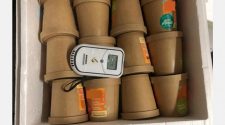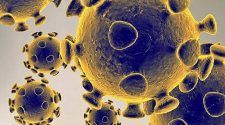Coronavirus hasn’t been cured, but engineering innovations like 3D printing, medical robots and antimicrobial coatings are helping fight against COVID-19.
3D-printed respirators
As more hospitals see an influx of COVID-19 patients, equipment to treat symptoms is in short supply. Hospitals in hard-hit Italy have been overwhelmed and are running out of space and equipment, including crucial valves for respiratory machines, which help people breathe mechanically by ventilating their lungs.
When a hospital in the northern city of Chiari, near Milan, was at risk of running out of this life-saving equipment, smaller manufacturers came to the rescue using 3D printing.
Massimo Temporelli, founder of digital manufacturing lab FabLab, worked with Cristian Fracassi, founder and CEO of engineering company Isinnova, and Michele Faini, a 3D-printing expert, to design and produce the replacement valves.
As they weren’t able to obtain design information from the valve’s manufacturer, the team had to reverse engineer the product themselves. Fracassi and mechanical engineer Allessandro Romaioli inspected the valves and produced a prototype within three hours.
“We were ready to print the valves in a couple of hours, and the day after we had 100 valves printed,” Fiani said.
The team has enlisted the help of another 3D-printing company, as each valve is extremely detailed and takes up to an hour to print, meaning many machines are required to produce the necessary volume of devices.
“The valve has very thin holes and tubes, smaller than 0.8 m — it’s not easy to print the pieces,” Fracassi said.
Word has spread, and requests are coming in from all over for the 3D-printed valves, as well as the design files to print them elsewhere.
The call has gone out to engineers and designers elsewhere to contribute ways to prevent equipment shortages like this, as hospitals face unprecedented demand. For example, a design engineer posted on Hackaday a challenge to their peers to design an open-source ventilator in time to help address equipment shortages.
UK Prime Minister Boris Johnson has encouraged engineering firms and manufacturers to consider if they can switch production lines to produce ventilator equipment. And the 3D Printing Media Network has created a forum for hospitals, additive manufacturers and makers to share ideas to combat the COVID-19 pandemic.
Antimicrobial coatings
Chemical and biological engineers at the Hong Kong University of Science and Technology (HKUST) have developed a multilevel antimicrobial polymer (MAP-1) coating they say can inactivate 99.99 per cent of highly infectious microorganisms, including viruses that are more resistant than the coronavirus responsible for the COVID-19 epidemic.
The coating works by disrupting the microbial envelope, rendering a microorganism inactive; this is coupled with anti-adhesion technology to keep surfaces free from microbial contaminants.
Field studies found applying the coating to hospital privacy curtains resulted in a 98.7 per cent reduction in drug-resistant bacteria over a three-week period. The MAP-1 coating has also recently been applied to surfaces in high-traffic areas such as daycare centres, elderly care homes and shopping malls to help stem the spread of coronavirus.
According to team lead Professor Yeung King Lun, of the Department of Chemical and Biological Engineering, the coating has a life of 90 days and is versatile enough to be applied to surfaces such as wood, metal, concrete, glass, plastics and fabrics. The non-toxic nature of the coating means it’s also safe for use in air- and water-purification systems, as well as clothing and surgical masks.
This same team previously developed antimicrobial air-purification systems to combat the spread of various strains of influenza such as H1N1, as well as EV71 and MERS-Cov. More recently, the technology has shown it’s effective against the spread of novel coronavirus, and has been applied in Wuhan’s Huoshenshan Hospital, a 25,000-square-metre, 1000-bed hospital that was built specifically to treat patients with coronavirus.
Send in the robots!
Helper robots can get a bad rap because … well … they aren’t exactly human-like, but right now that might be their biggest selling point. Areas that have seen high rates of infection are turning to robots to help minimise human-to-human contact and provide some relief to overworked medical staff.
Hospitals in China are using robots for everything from food and medicine delivery, to disinfecting rooms and even providing some level of companionship for people in quarantine.
Guangdong Provincial People’s Hospital is using two autonomous robots to deliver medicines. The robots can take the elevators and open and close doors. According to the hospital, one robot can carry out the work of three delivery persons. The aim is to reduce the risk of exposure to clinical staff.
Similarly, a Wuhan field hospital has opened an entire ward run by robots in a bid to protect medical staff from contracting COVID-19 and provide some much-needed relief for overworked practitioners.
The ward is using 12 sets of 5G-powered robots to perform functions including monitoring patients’ vitals and sending real-time updates to doctors, delivering food and medicines, disinfecting rooms and equipment, and disposing of medical waste. One robot, named Ginger, is even being used to keep morale up by leading dance routines and interacting with patients.
Danish company UVD Robots has also sent armies of disinfecting robots to hospitals in a bid to contain the spread of COVID-19. Each robot consists of a mobile base equipped with LIDAR sensors and an array of powerful short wavelength ultraviolet-C lights that emit enough energy to fry the DNA or RNA of any microorganism unlucky enough to be in its way.
It takes between 10 and 15 minutes to disinfect a room. According to CEO Per Juul Nielsen, the company developed the robot to reduce the rate of hospital acquired infections, but now focus has shifted to helping stop the spread of COVID-19.
“There’s a big need for our robots all over the world now, because they can be used in fighting coronavirus and for fighting all of the other infections that are still there [in hospitals],” Nielsen said.















